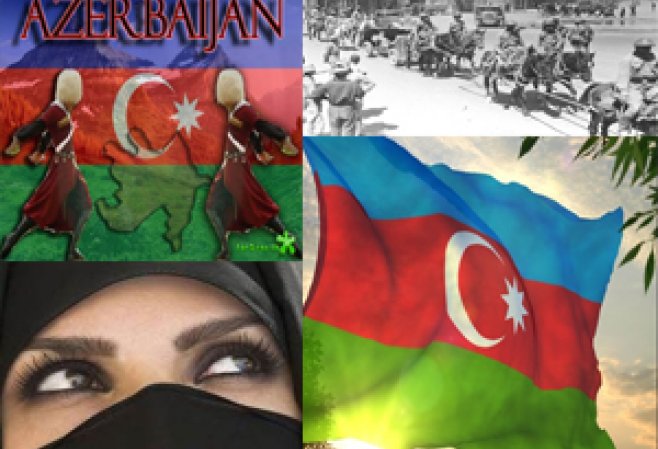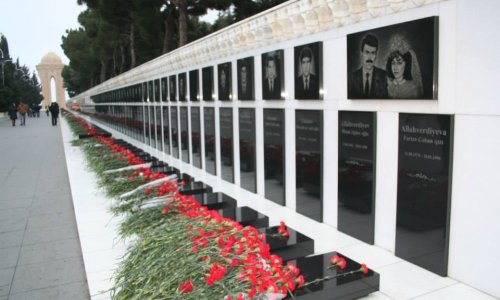By Dr. Aydin Balayev
Azerbaijanis as an ethnos developed in an area crisscrossed by long caravan routes connecting the Mediterranean region and Europe with India and China, as well as western Siberia and north-eastern Russia with Iran, Byzantium and Arab countries.
Because of its special geographic location of being at the crossroads of Asia and Europe, the area had long served as a route for migration of peoples. The rich natural resources and strategic location of the region attracted the attention of various invaders from ancient times.
The territory where Azerbaijani Turks emerged had been an area where ethnic groups interacted actively, which explains the extremely controversial and complex nature of the process of formation of the Azerbaijani ethnos.
The origins of Azerbaijani Turks have been poorly studied by both local and foreign historians for some objective circumstances and also political reasons. We should bear in mind that this is not only an issue of scientific and educational importance but also serious political significance.
The ruling regimes in both the Soviet Union and Iran, which controlled Azerbaijan in the past century, tried to manipulate the issue in pursuit of their imperial interests.
Therefore, the vast majority of historians in the Soviet Union and Iran approached the issue of the formation of the Azerbaijani ethnic group from the standpoint of traditional imperial policies and not from a scientific viewpoint.
Azerbaijani Turks bore the brunt of this policy. One of the main elements of the Soviet policy of mankurtizatsiya (making a community forget its ethnic roots) in Azerbaijan was the total falsification of the ethnic history of Azerbaijani Turks. The ramifications of this policy have yet to be fully cleared despite the fact that Azerbaijan regained its independence in 1991.
This pseudo-scientific "concept" on the origins of Azerbaijanis Turks emerged in the early 50s of the twentieth century on direct orders from the Kremlin. It claimed that Azerbaijani Turks have no historical links with the territory they inhabited and where they live at the moment. The authors of the concept also denied the Turkic origin of modern Azerbaijanis. By manipulating historical facts, they sought to prove that there is no genetic relationship between modern Azerbaijanis and old Turks.
Contrary to obvious facts, they claimed that Azerbaijani Turks are "Turkified Persians”. Thus, the supporters of this "concept” claimed that the Turkish-speaking population was alien to the present territory where Azerbaijanis live.
The attempts to falsify the history of the formation of the Azerbaijani ethnos pursued far-reaching political goals. They aimed to destroy the historical memory of Azerbaijani Turks. The most important condition for the existence and development of any ethnic system is the optimal combination of continuity and innovation. If the ratio and balance between these two elements change, ethnic communities risk erosion, disappearance, infertility, or congestive deadlock at best.
Through mankurtizatsiya, the authors of the theory on Iranian roots of Azerbaijanis were seeking to facilitate the task of integrating Azerbaijanis into the structure of the single (or united) Soviet nation and speed up the process of shaping their common Soviet identity. Another important goal of the supporters of this "theory" was to "protect” Azerbaijani Turks from any cultural and political influences of Turkey. Any attempt to call into question the scientific validity of this "concept" was harshly repressed by the Soviet regime. Those questioning this theory were accused of political disloyalty.
Even at the height of perestroika, when the freedoms of expression and thought were provided to some extent compared with the period of Stalinism and the years of Brezhnev stagnation, one of the apologists of the "theory" wrote in the Journal of Ancient History: "Claims that the Turkic element has deep roots in Asia Minor or even that Turks are aboriginal peoples of the region are mostly traced to Pan-Turkism and other ideas of Turkic nationalism.”
It must be remembered that the main provisions of the "theory" of Iranian roots of Azerbaijani Turks were copied by Soviet historians from the works of Amed Kesrevi, one of the founders of Pan-Iranism who devoted his entire life to the denial of Azerbaijani identity. At the very least, the main idea of this "theory" that Azerbaijan was Turkified in the eleventh and twelfth centuries was taken from a book ("Azeri or the ancient language of Azerbaijan) Kesrevi published in Persian in Tehran in 1926. It was no coincidence that Kesrevi’s book was published right after the Pahlavi dynasty came to power in Iran in 1925. There was not a single Persian among the rulers of Iran for nearly a thousand years before that. Turkic dynasties played a dominant role in the political life of the country. Suffice it to mention that Iran was ruled by the Turkic Qajar and Safavid dynasties in the past four centuries.
Azerbaijani Turks held leading positions in various walks of Iranian life at the time Pahlavis took over. This was unacceptable for the Pahlavi dynasty, which was seeking revenge. Pahlavis started to force Azerbaijani Turks out of key positions in the government and society. At the same time, the Azerbaijani population of Iran was subjected to targeted cultural and linguistic assimilation by Persians. Ahmed Kesrevi, himself an Azerbaijani Turk, took credit for laying the ideological foundations for this chauvinistic policy. The ruling Pahlavi dynasty set a specific task to Kesrevi to do everything to prove that Azerbaijani Turks in their genetic roots are not Turks but Persians. Kesrevi tried to give a "pseudo-scientific" shape of this political paradigm by manipulating historical facts for the benefit Iranian ruling circles.
Brenda Shaffer, who led a Caspian studies program at the John F. Kennedy School of Government at Harvard University, says that Kesrevi’s ideological views and his political goals warranted the direction and nature of his research into Azerbaijan’s history. Long before Shaffer, Soviet orientalist B.V.Miller, who was a renowned expert on Iran, shared similar views on Kesrevi. Drawing attention Kesrevi’s politically motivated works, Miller wrote in 1930: "Kesrevi is sincerely convinced that the whole of Persia should speak only in one language, Persian. He believed that with Azerbaijan’s Turkification completed many centuries ago, it is not the end of the story. As the means of communications improve in Iran, Persian will force the Turkic language out.” As a "Persian patriot”, Kesrevi was not happy that the Turkic republic in the Trans-Caucasus was called Azerbaijan, Miller said.
Of course, we are far from denying the fact that Iranian and Caucasian elements did play a role in the formation of the Azerbaijani ethnos as they lived side by side in the same region for centuries. In today’s world, there is no ethnic community that avoided mixing with others, and Azerbaijani Turks are no exception. Yet, it was Turkic tribes that played the dominant role in the formation of Azerbaijani Turkic ethnos.
www.ann.az
Follow us !








